 (CTT i +FE i )+ CI] /Nacc
(CTT i +FE i )+ CI] /NaccVol. 13 No. 2 July 2002
Jerry Johansson
Tomas Gullberg
Dalarna University
Garpenberg, Sweden
The authors are, respectively, Researcher and Research Leader at Dalarna University.
ABSTRACT
Harvesting very small trees one by one has always been comparatively unproductive. Multiple-tree handling creates opportunities to reduce time per tree and thereby make it profitable to harvest small trees instead of thinning to waste. Multiple tree-handling is achieved by felling more than one tree in one cut or by felling one tree per cut and accumulating trees on the felling head, thereby handling several trees during one crane cycle.
The effect of accumulating trees depends on how much faster each additional tree can be felled (positioning head and cutting off) compared with the previous tree and how much time (per tree) is saved when moving several trees during crane-in (bunching). Felling several trees in one cut reduces time per tree substantially, but is often of limited relevance due to spacing between trees.
Field studies showed significantly lower time consumption when accumulating smaller tree sizes. Reduction of time consumption for crane work was approximately 40 % for the smallest trees. The difference decreased as tree size increased. Time consumption for the first "crane to tree" was a little higher than for the following crane movements to trees to be cut. Time for "crane-in" only slightly increased with the number of trees in the felling head. The time required to fell two or more trees in one cut was not significantly different than for a single tree, giving a substantial reduction in time per tree.
Keywords: accumulation, felling head, forest fuel, multiple tree handling, Pinus silvestris L., Sweden.
INTRODUCTION
Harvesting small trees one by one has always taken considerably longer to harvest a given volume of wood as compared with larger trees. Thus, the use of conventional logging equipment often results in costs that are greater than the value of the harvested wood, making it less expensive to thin to waste [2] . However, quite large volumes of small trees may be an important source of energy if harvesting methods less sensitive to tree size can be developed.
Studies and discussions about the advantages of multiple handling of trees started relatively early, but the studies mostly concerned early thinning. One example is the study by Bredberg and Moberg [4] in which time consumption was studied in situations where one, two, or three trees were accumulated in the felling head of the thinning machine. It was estimated that time consumption could be reduced by up to 38% by accumulation. This study was followed up by a survey study (literature, patents etc.) of different solutions for felling head and machine concepts [3] . In the same year, a simulation model for thinning machines was developed which was applicable for multiple tree (bouquet) handling. The machine concept consisted of components partially known at that time, and was partially used in a prototype in Latvia [16].
One machine that later came into practical use was the Makeri tracked feller/buncher. The felling head was attached directly to the base machine [9 , 12] . Consequently, the whole machine had to be positioned instead of only the felling head which, together with the tracks, made it suitable mainly for flatlands. Another machine was the Kockum 81-11 which was equipped with an accumulating felling head for small trees [11] . This felling head was attached to a crane. Different solutions for multiple tree handling with single-grip harvesters have also been studied [10] .
The situation is different in North America, where accumulating felling heads are more common. One example is the Timbco Hydro-Buncher, which could be equipped with or without accumulating shear heads [19] . The Mor-Bell feller-buncher was equipped with accumulating shear, and the design allowed extension of the shear head more than one meter [20] . Later circular saw felling heads were introduced [21] . A simulation study in second thinning showed that productivity for a Morbell feller-buncher was significantly affected by site and stand factors [7] . The most important factors were average tree diameter and number of trees per accumulation. Less important, but still significant, were bunch size, the spacing between corridors, and the average distance between trees. Schroering et al. [17] found that variables affecting the overall productivity included the number of residual trees per acre, average diameter, number of trees in the shear head, and thinning method. The machine studied was the Franklin 105, a four-wheel drive, articulated frame feller buncher. In a performance study, Gingras [6] found that the number of trees per accumulation was important for productivity. Stand and site factors of importance were the relation between unmerchantable and merchantable trees, stand density, and average diameter.
When comparing a "single-system" and a "multi tree-system" in early thinning, Sluss [18] found that the "multi- tree system" indicated 3% higher productivity for the harvester and 2% for the forwarder. The system consisted of a conventional single-grip harvester (Gremo 802/SK35) and a forwarder (Gremo 604). However, it was only a small study, and "multi-tree" meant that two trees were felled and processed at a time when possible (i.e., when the trees were standing close to each other).
There is, however, a lack of models of multiple tree handling that could use further development of machines and methods.
During recent years, increasing interest in harvesting small trees from dense stands for energy has started development of felling-accumulation technology for small trees, especially in the Nordic countries. This is of interest mostly in young stands, pre-commercial thinning and high density first thinning stands (not short rotation). The density is often in the range of 3000 to 15000 trees per hectare, and the diameter at breast height varies from 1 to approximately 15 cm. The need for treatment of this type of stand is large; only about half of the area in Sweden that needs treatment per year is in fact being treated [5 , 14] .
The following study was implemented to contribute to further development of multiple tree handling technology.
OBJECTIVES
This paper is divided into two parts, each of which addresses one of its two objectives:
MATERIAL AND METHODS
Some terms used in this paper are defined in specific ways.
General discussion about principles to reduce time consumption
Time consumption per tree for crane work can principally be reduced by:
It may seem obvious that speeding up different elements will decrease time per tree. However, most machines are designed for tree sizes close to maximum capacity, making time consumption nearly constant regardless of tree size. If forces, speed etc. could be adjustable and adapted to single trees, time consumption for small trees should be reduced. One example is the cutting knife on the felling head studied where less force is used to cut the small trees more quickly.
The possibilities connected with different ways of multiple tree handling will be discussed later.
Selective felling often causes long and difficult crane movements around remaining trees. The decision process (and time) may also be a factor to take into account. A more or less geometric felling pattern gives possibilities of both reducing moving distances and making moving easier, thereby speeding up crane movements.
Single tree handling is the conventional method for tree handling. In this study this is used as the reference method. Felling (and bunching) work can be separated in the following way:
CT = CTT+FE+CI
CT = crane time per tree in single tree handling
CTT = time for moving the crane to tree
FE = time for positioning the crane and felling
one tree
CI = time for moving the crane with the felled tree
to the machine/bunch
Multiple tree handling can principally be done by felling more than one tree in the same cut or by accumulating several trees in one crane cycle.
Felling more than one tree in the same cut will result in more trees being handled during the same crane movement with little or no extra time per crane cycle. If time for felling (multi) and crane-in (multi) is the same as for single tree handling, time per tree will be reduced substantially. The reduction will be proportional to the number of trees handled. The relative effect is largest going from one to two trees. Even if both time for felling (multi) and crane-in (multi) is increased in proportion to "number of trees" it is preferable, as time for crane to tree is lower per tree.
CT = (CTT +FE+CI)/Nmulti
CT = crane time per tree when felling more than
one tree in the same cut
Nmulti = number of trees per cut (crane cycle)
In practice, the cut area and the distribution of stems to be felled affect the possibilities of felling several trees in the same cut. Machine capacity will also set limitations on how many trees of a certain size it will be possible to handle. The extra time is likely to increase as the machine's maximum capacity is reached. Close to or over machine capacity, it may be preferable to handle fewer trees per cut or crane cycle.
Accumulating several trees in one crane cycle can reduce crane movements. This is partly because more trees are handled during crane-in. Further crane movements to trees in the same crane cycle are likely to be shorter in time and distance than the first. This also reduces crane movement. In addition, the average distance for the first crane to tree (when using accumulation) can be shorter than the average distance to all trees to be felled if a good working scheme is used. The reduction of time consumption is dependent on how much lower the extra time for accumulating one additional tree is, compared with conventional/single tree handling. The model below describes crane time, and the index acc denotes that accumulation is used. The index i denotes felled tree number i, and n denotes the number of felled trees per crane cycle.
CT =[ (CTT i +FE i )+ CI] /Nacc
(CTT i +FE i )+ CI] /Nacc
CT = crane time per tree when using accumulation
CTT i = time for crane to tree number 1 to n
FE i = time for positioning, felling, and
accumulating trees number 1 to n
Nacc = total number of trees per crane cycle
In practice it is likely that the extra time to accumulate one additional tree will increase as the total number of trees increases, as this will give more difficult handling (increased crown friction etc.). Myhrman [13] showed in one study that when handling single trees (Picea abies and Pinus silvestris) with a weight of 150 – 600 kg with a 10-meter boom, crown contact normally caused additional forces representing stresses 15 – 20% higher than those occurring when no crown contact is experienced. How much the additional time increases can be assumed to depend on tree size in relation to machine capacity. But factors like sight and spacing between remaining trees are also important. In other words, when the number of trees in the felling head increases, a certain point will be reached when the drawback of increased difficulty in work will exceed the advantages. Hence, there is an optimal number of accumulations where the crane time per tree is lowest.
The optimum number of trees will probably depend on factors such as the relationships between working conditions, operator skill, and machine capacity. Thus, when trees are small, conditions are easy and the machine has high capacity, it will be preferable to accumulate more trees than under contrasting conditions. In practice, the number of available trees will limit the possibility to fill the felling head. If a large number of trees are cut per hectare, moving distances between trees will be short, making it preferable to have a relatively high average number of accumulations. If the removal is low, long moving distances may result in an optimum with fewer trees per crane cycle. Machine capacity will also set the absolute limitation of handled trees of a certain size.
In practice there are possibilities of combining multiple-tree handling with both accumulation and felling several trees at a time, making it possible to save even more time when conditions are favourable.
If felling and accumulation are very effective and, in practice, take no "extra" time, the total time per tree will most likely be dependent on the number of trees per harvested area. One example of this technology can be found in harvesters for energy crops. So far no such equipment for selective felling in forests exists. However, several ideas on such machines can be found in the literature [1] .
Empirical study
Short Description of Study Conditions
The machine. The base machine was a small forwarder. The stakes and the crane had been removed and were replaced by a larger crane and a clam bunk. The felling device was a small accumulating felling head (Figure 1). The cutting device was a knife working in different ways depending on the force required to cut the tree. The knife was slightly extended (in a cutting position) from the beginning already when starting to grab the tree. If the tree was not more than approximately 7 cm in cut diameter, the force from the grapple arms was usually enough to cut the tree. If the tree was more than about 7 cm in cut diameter, the lower grapple arms automatically connected and formed a support when the knife started to move. Data for the base machine and the accumulating felling head used in this study are shown in Table 1.
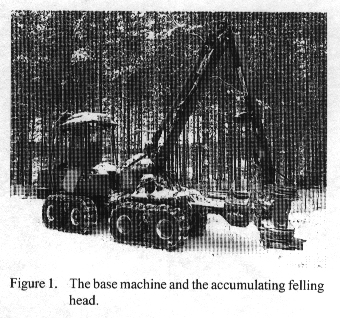
Study areas. The study was carried out in three pine stands (Pinus silvestris) in central Sweden. The age of the stands was approximately 40 years. In stands No. 1 and No. 2 the smallest trees had been cut down (non-commercial) some years ago, but stand No. 3 had never been thinned before. This resulted in a larger variation of tree diameters per crane cycle. The stands are briefly described in Table 2.
Work method. The machine was normally working on strip roads and spurs branching perpendicularly from these (Figure 2). The spurs were approximately 20 m long. First the strip roads were harvested with the machine, and then the spurs were harvested. The machine moved backwards on the strip roads and the spurs. At the same time the trees standing in the driving direction were felled.
The felled trees were then put aside on the ground. When working on the spurs, the last spur-trees were placed directly in the clam bunk. Thereafter, trees on both sides of the spurs, within crane reach, were felled and placed in the clam bunk. The trees felled and put on the ground earlier were also placed in the clam bunk. Gradually the machine moved forward towards the strip road. At the strip road the clam bunk was opened, the machine moved forward and the trees fell to the ground. The machine then moved to another spur.
Table 1. Data for the machine.
| Base machine
- engine power - transmission - driving Crane - reach Felling head - weight - maximum accumulation area (at stump height) - cutting device Total machine weight |
Rulle 3.35 (including clam bunk)
35 kW
Hydraulic 8 wheels + tracks Parallelogram 6.9 m EnHar 300 kg 630 cm2 Knife Approx. 8400 kg |
|
Table 2. Stand data.
| Stand 1 | Stand 2 | Stand 3 | |
| Removed: | |||
| Mean diam., cm (range) | 8.7 (1--16) | 8.1 (1--15) | 5.7 (1--15) |
| Mean height, m | 11.2 | 9.2 | 8.5 |
| No. of trees/ha | 1672 | 1854 | 3399 |
| Remaining: | |||
| Mean diam., cm (range) | 11.0 (4--25) | 10.9 (2--20) | 6.8 (1-20) |
| Mean height, m | 12.5 | 9.5 | 9.4 |
| No. of trees/ha | 1873 | 1818 | 3775 |
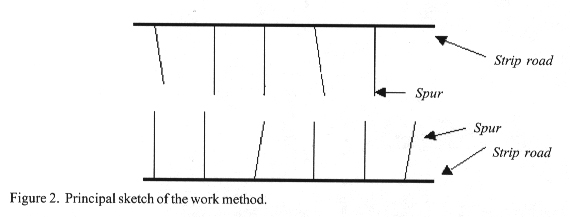
Study method. The study was carried out on spurs. The diameters of all trees were marked on the stems in advance. A Husky Hunter hand-held data computer was used for the time study. Data for each tree felled and accumulated was recorded, and also in what order the trees were felled. The spurs were randomly divided into two groups (treatments), with and without using accumulation.
In the following analysis only the crane work (moving, felling, and bunching) will be examined. It is also limited to crane cycles where trees were felled and bunched in the clam bunk or in a bunch. This means that most road trees are omitted from the analyses. Altogether 719 trees (442 crane cycles) are included in the study.
RESULTS
This study is analysed according to the principles discussed earlier to create a time-consumption model for crane work. In the first step, the extent of multiple handling for different tree sizes is described and a model is formulated. In the second step, the same is done for the time elements. Thereafter, both models are used to demonstrate the effect of different levels of multiple tree-handling for different tree sizes.
Extent of multiple tree handling with and without accumulation
The number of trees per crane cycle increased as average tree size decreased (Figure 3). The upper limit for accumulation was an average tree size of about 12 cm at breast height. The few observations in the 3-cm class limit conclusions that can be drawn for this class.
The average number of trees felled in one cut is shown in Figure 4. For tree sizes larger than about 10 cm only single trees were cut. When using accumulation the average number of trees was 1.04 in diameter classes up to 9 cm and 1.0 for larger trees.
The total basal area per crane cycle was increased substantially for small tree sizes by using accumulation (Figure 5). However, the area was still lower for small trees compared with larger tree sizes up to the tree size where multiple tree handling no longer occurs.
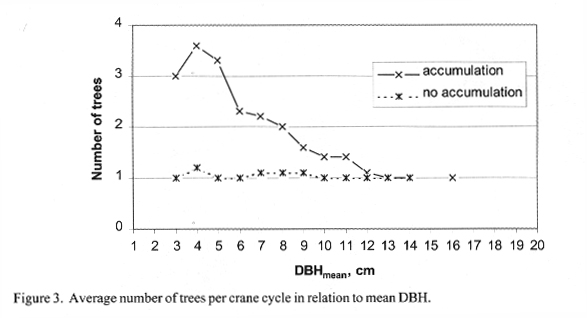
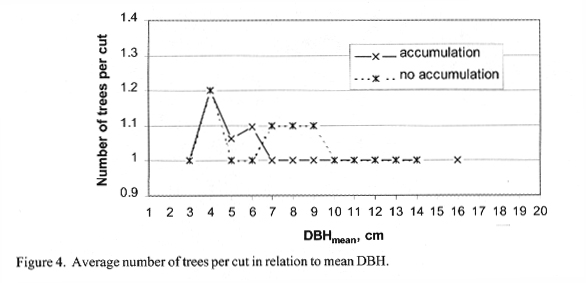
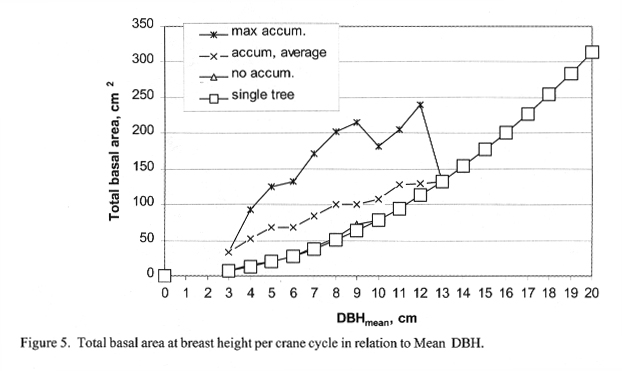
Areaacc (average)= A + B * DBHmean
| Variable: | Coeff.: | P-value: | Lev. of sign: |
| Constant | 17.86 | 0.58 | (-) |
| DBHmean, cm | 9.46 | < 0.001 | *** |
| R2adj=0.20; | F-value = 71.8 | ||
The relatively low R2 is partly due to large variation in accumulated area.
For diameters greater than or equal to 12 cm the accumulated area (cm2) = π * DBH2 / 4.
The maximum level during the studies indicates a level close to 200 cm2. The maximum level increased about 100% from 4 cm to 12 cm at breast height. This level of multiple tree handling is possible for very good conditions, e.g. high removal of stems per ha and easy ground conditions.
The total maximum accumulated area can be formulated according to the following model (manually adapted):
| Variable: | Coeff.: |
| Constant | 150 |
| DBHmean, cm | 8.5 |
The average number of trees in specific diameter classes can then be calculated as total basal area divided by the basal area for one tree.
Time consumption for time elements crane to tree and crane in
Models for time consumption were constructed by using regression analysis. The models for crane to tree (including felling time) indicated significantly higher time consumption for the first crane to tree in general, and even higher time consumption if no accumulation was done. Thus, the first crane to tree was 2.48 (2.13 + 0.35) cmin higher than later crane to tree in the same crane cycle when using accumulation. There was no significant influence for the order of accumulation. In other words, time did not increase when the number of accumulations increased. One reason for including felling time in crane to tree was that it was not possible to measure (it was mostly too short), and sometimes it was combined with time for positioning the head and closing the grapple.
Model: Time per crane to tree (crane to tree 1, crane to tree 2 etc.), cmin =
C1 + C2* No accum. + C3 * First crane to tree + C4 * DBH
R2adj=0.10; F-value=25.2
| Variable: | Coeff.: | P-value: | Lev. of sign: |
| Constant | 9.96 | <0.001 | *** |
No accum1) |
2.13 | <0.001 | *** |
First crane to tree2) |
0.35 | <0.001 | *** |
DBH, cm |
1.54 | 0.002 | ** |
1) dummy: no accum. = 1, either by method or by
too large trees (>12cm), accum. = 0.
2) dummy: first = 1, else = 0.
The model for crane-in indicated increased time consumption for increased tree size and number of trees. The method (accumulation or not) did not show any significant influence in combination with the other variables. The R2-values are low, which partly can be explained by the fact that times are relatively constant.
Model: Time for crane-in, cmin =
C1 + C2* DBHmean + C3* Number of trees
R2adj=0.15; F-value=40.3
| Variable: | Coeff.: | P-value: | Lev. of sign: |
| Constant | 2.40 | 0.220 | - |
DBHmean, cm |
1.55 | <0.001 | *** |
| No. of trees (per crane cycle) |
2.66 | <0.001 | *** |
Time consumption for different tree sizes by using the model
Time consumption per crane cycle was calculated for the different diameter classes by summing up times for the numbers of crane-out and crane-in according to the model above.
The total number of trees per crane cycle was estimated by dividing the total basal area per crane cycle by area per tree.
The number of accumulations per crane cycle was estimated dividing total number of trees per crane cycle by the number of trees per cut.
An alternative way to estimate the number of trees per crane cycle and the number of accumulations per crane cycle is to analyse directly according to recorded (studied) values. However, using a model based on basal area is more general for different sizes of harvester heads, and gives connections to basic machine characteristics.
The effect of accumulation was largest for small trees. The effect was higher and less dependent on tree size during very good conditions (maximum accumulation). Modelled versus observed time per tree is shown in Figure 6.
DISCUSSION
The study shows that multiple tree handling can reduce time consumption. However, in the analysed study, time reduction due to accumulation was not as large as expected. One important reason is that time for crane to tree was nearly as long for one additional felling as for the first. Reduction of time was larger for crane-in when bundles of cut trees were moved instead of handling the trees one by one.
To improve the accumulation and better utilise the possibilities connected with accumulation, it is important to reduce time for crane movement between trees to be felled. This could be achieved for example by simplified crane movements, and reduced time for felling and accumulating trees. Strict selective cutting causes many long and difficult crane movements. These movements might be shorter and easier if a more or less geometric felling is used. One example is corridor felling. Peters [15] showed that more trees could be accumulated in row thinning and clear-cutting of larger trees. The decision/planning process and its time consumption are also factors to consider.
Accumulation is limited to smaller trees by the felling head capacity. Larger trees can only be handled singly. The tree size should, therefore, not be larger than about half of the maximum capacity. Peters [15] pointed out that, when felling larger trees, shear or saw diameter should be two or three times tree diameter at breast height.
An assumption that time per extra felling increases with the number of stems accumulated and leads to an optimum accumulation number could not be verified in the study. One reason might be that many accumulations are made when conditions are good, and vice versa, giving the result that the increased difficulty when handling more trees is counterbalanced by good conditions. A strict experimental study design where the operator is forced to work in specific ways might show that there are optimum numbers of trees.
The accumulating effect is largest for small trees. However, harvesting the smallest trees is still more costly than harvesting larger trees. It was shown in one study that 74 trees in the smallest diameter class (DBH<1.5cm) contained less amount of dry substance than one tree in the diameter class 10.5-11.5 cm at breast height [8] . However, leaving too many of the smallest trees might disturb work and lead to poorer view in the stands.
In order to lower costs the investment must not be high. In this case, investment can be kept low by restricting the base machine. This may result, however, in low ergonomic standards and productivity (including mobility) as well as damaged residual trees.
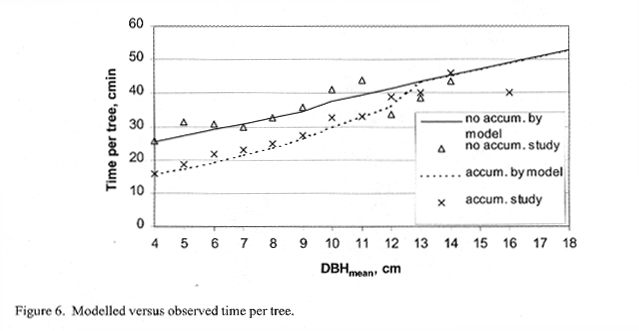
The operator is very important. The more complex the work (method and machine) the more important is the operator. The operator's skill is crucial with regard to the ability to exploit the new possibility to obtain good productivity and, at the same time, avoid damaging remaining trees. This is most critical in dense stands, especially if the distribution of trees is not even. At the same time, stands with high density often have the highest volume, which might lead to the best economy.
The model by Gingras [6] gives more factors influencing productivity, but some of them are on a stand level such as stand density. The model by Gingras is of use mainly when calculating productivity. This study considers smaller trees at an experimental level and the models it presents should be more useful for development of the machine, felling head or work method.
CONCLUSION
Multiple tree handling can theoretically reduce time consumption substantially. However, reduction of time was not as high as expected in this study. This depends largely on the high time consumption for crane-to-tree elements where the crane and felling head have to be moved "around" remaining trees in selective thinning. More developed work methods and technology could make it possible to benefit substantially from the high potential for productivity increases from accumulation.
AUTHOR CONTACT
Dr. Johansson can be reached by e-mail at -- gje.j@swipnet.se
REFERENCES
[1] Berg, H., Bäckström, P.-O., Gustavsson, R. and Hägglund, B. 1973. Några system för ungskogsröjning – en analys [Some systems for pre-commercial thinning of young stands – an analysis]. Logging Res. Found., Sweden. Rep. No. 5. 74 pp.
[2] Björheden, R. 1992. Logging in hardwood stand established on former farmland. Vattenfall. U(B) 1992/6. 37 pp.
[3] Bredberg, C.-J. and Moberg, L. 1972. Felling heads designed for simultaneous handling of several trees. Royal Coll. of For., Dept. of Op. Efficiency. Research Note No. 51. 33 pp.
[4] Bredberg, C.-J. and Moberg, L. 1971. A pilot test on the handling of several trees in a felling head. Royal Coll. of For., Dept. of Op. Efficiency. Research Note No. 46. 19 pp.
[5] Bäcke, J. 1998. Gallringsundersökning 1997 [Thinning stands treated and in need of treatment respectively 1997]. Meddelande. Nat. Board of For., Sweden. No. 8. 23 pp.
[6] Gingras, J.-F. 1988. The effect of site and stand factors on feller-buncher performance. For. Eng. Res. Inst. Can. Tech. Rep. TR-84. 23 pp.
[7] Greene, W., D., Lanford, B., L. and Mykytka, E., F. 1987. Stand and operating effects on feller-buncher productivity in second thinnings of southern pine. For. Prod. J. 37 (3):27-33.
[8] Gullberg, T., Johansson, J. and Liss, J.-E. 1998. Studie av system EnHar vid uttag av skogsenergi i unga bestånd [Study of the EnHar-system harvesting forest fuel in young stands]. Arbetsdokument Dalarna University, Forest Industry Department. No. 9. 34 pp.
[9] Hakkila, P. and Wòjcik. 1980. Thinning young pine stands with the Makeri tractor in Poland. Folia Forestalia 433. 29 pp.
[10] Myhrman, D. 1989. Teknik för flerträdshantering på engreppsskördare. [Technology for multiple-tree handling with single-grip harvester]. For. Op. Inst. Sweden. Resultat. No. 20. 4 pp.
[11] Myhrman, D. 1983. Kockum 81-11 fällare-sammanförare för gallring – maskinbeskrivning [The Kockum 81-11 feller-skidder for thinning – a machine description]. For. Op. Inst. Sweden. Resultat. No. 6. 4 pp.
[12] Myhrman, D. 1981. Felling and yarding – the stumbling blocks in thinning. Logging Res. Found., Sweden. Report No. 1. 60-64. (English summary.)
[13] Myhrman, D. 1970. Handling of trees in vertical position. Logging Res. Found., Sweden. Report No. 13. 25 pp.
[14] Pettersson, B. and Bäcke, J. 1998. Röjningsunder-sökning 1997 [Pre commercial thinning stands treated and in need of treatment respectively 1997]. Meddelande. Nat. Board of For., Sweden. No. 7. 15 pp.
[15] Peters, P., A. 1991. Correlating production of accumulating feller-bunchers. Transactions of the Am. Soc. Ag. Eng.Pap. No. 89-7546:1024-1030.
[16] Santesson, M. and Sjunnesson, S. 1972. Simulation model for thinnings machines. Royal Coll. of For., Dept. of Op. Efficiency. Research Note No. 49. 78 pp.
[17] Schroering, J., D., Lanford, B., L. and Stokes, B., J. 1985. Franklin 105 Feller Buncher: fifth-row thinning application. South. Journ. Appl. For. 9(2):110-113.
[18] Sluss, R. 1991. Flertraeskovning – fremtiden for de tidige tyndiger [Multiple-tree handling – the future for early thinnings]. Danish Inst. of For. Tech. No. 3. 28 pp.
[19] Stokes, B., J. and Lanford, B., L. 1983. Evaluation of Timbco Hydro-Buncher in southern plantation thinning. Winter Meeting. Am. Soc. Ag. Eng. Pap. No. 83-1600. 11 pp.
[20] Stokes, B., J., Lanford, B., L. and Sirois, D., L. 1982. Mor-Bell thinning system: feller buncher, skidder and loader. Am. Soc. Ag. Eng. Pap. No. 82-1590. 12 pp.
[21] Williams, W., A. 1990. Performance of circular saw felling heads in hardwood conditions. For. Eng. Res. Inst. Can. Tech. Note TN-156. 6 pp.